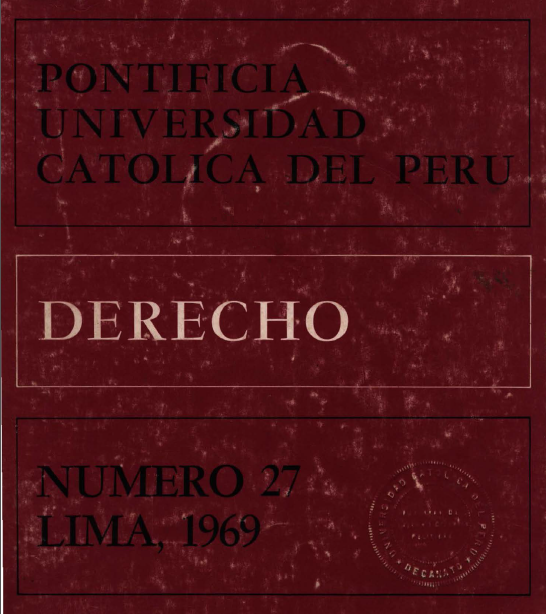El derecho como instrumento de cambio social incremental
DOI:
https://doi.org/10.18800/derechopucp.196901.003Palabras clave:
Derecho, sociedad, cambio social, cambio legal, instrumento público, relaciones sociales, cambios formalesResumen
Históricamente, la ciencia social ha relegado la función del derecho a una de control social. Debido a ello, el presente artículo pretende destacar la importancia del derecho como instrumento de cambio social. En ese contexto, los autores abordan la relación entre el derecho, el cambio legal y el cambio social a través de diversos ejemplos que reflejan en qué medida el derecho incide en las demandas sociales. Así, el artículo establece que el derecho es un mecanismo que regula las relaciones humanas con el fin de conseguir metas sociales. Por su parte, el cambio social puede ser entendido como una modificación evidente en los patrones de conducta y relaciones entre las personas, que emana de la decisión consciente y racional de los individuos para solucionar sus problemas. Ahora bien, el cambio legal es aquel cambio que se produce en el mundo legal; sin embargo, para poder comprender mejor este cambio deben evaluarse los tipos de relaciones entre derecho y cambio social. El trabajo concluye señalando que el derecho actúa como un instrumento de cambio social al ser capaz de influir en el comportamiento de las personas, ya sea mediante la imposición de sanciones o la persuasión; y dicho cambio en la conducta solo podrá lograrse si la norma es comunicada y aceptada por la sociedad que pretender afectar.
Descargas
Citas
Rose, A. M. (1965). Sociology: The Study of Human Relations. (2da. Ed).
Deesing, P. (1962). Reason in Society.
Miller, A. S. (1963). Notes on the concept of the living constitution. The George Washington Law Review, 31(5), 881-918.
Friedman, L. (1966). “On Legalistic Reasining: A Footnote to Weber” Wisconsin Law Review. 148.
Wechsler, H. (1961). “Toward Neutral Principles of Constitutional Law”. Principles, Politics and Fundamental Law.
Bickel, A. M. (1962). The Least Dangerous Branch: The Supreme Court al the Bar of Politics.
Friedman, L. M. & Landinsky, J. (1967). Social Change and the Law of Industrial Accidents”, 67 Columbia Law Review 50, 72-77.
Thompson, E. P. (1963). The Making of the English Working Class.
David, S. (1966). Living Through the Industrial Revolution.
Laslett, P. (1965). The World We Have Lost: English Society Before and After the Coming of Industry.
Dahl, R. A., & Lindblom, C. E. (1953). Politics, Economics, and Welfare.
Braybrooke, D., & Lindblom, C. E. (1963). A strategy of Decision: Policy Evaluation as a Social Process.
Cyret, R. M., & March, J. G. (1963). A Behavioral Theory of the Firm.
Popper, K. (1945). The Open Society and Its Enemies.
Etzioni, A. (1963). The Epigenesis of Political Communities as the International Level. American Journal of Sociology, 68, 407-421.
Etzioni, A. (1963). European Unification: A Strategy of Change, World Politics, 16.
Hurst, W. (1960). The law in United States history.
Shapiro, M. (1965). Stability and Change in Judicial Decision-Making: Incrementalism or State Decisis? Law in Transition Quarterly, 2, 134-157.
Wells, R. S. & Grossman, J. B. (1967). The Concept of Judicial Policy-Macking: A critique. Journal of Public Law, 15, 308-309.
Honnold, J. (Ed). (1964). The Life of the Law, 100-143.
Holdsworth, W. S. (1922). History of English Law.
Thurman, K. E. (1966). The Married Women’s Property Acts. University of Winconsin Law School.
Gideon v. Wainwright, 372 U.S. 335 (1963).
Ann. Rpt. I.N.S., año terminado Junio 30, 1962, Tabla 6, p. 23
Ann. Rpt. Ins, año terminado Junio 30, 1957, p. 20.
Audiencias ante Subcomm. of Comm. on Judiciary, H. R., 89th Cong. 1st. Sess., on H.R. 2580, para enmendar la "Inmigration Nationality Act", p. 89. 20a 163 U.S. 537 (1896).
Sweatt vs. Painter, 339 U.S. 629 (1950).
Levi, E. H. (1962). An Introduction to Legal Reasoning.
Friedman, L. (1967). Legal Rules and the Process of Social Change,
Friedman, L. M. (1967). Legal Rules and the Process of Social Change. Stanford Law Review, 19(4), 786–840.
Priestley v Fowler. 3 Mees & Wels 1. (1837).
Murray vs. South Carolina Railroad. Co., 1 McM 385 (S. C., 1841).
Farwell vs. Bastan and Worcester Railroad Corp., 4 Mete. 49 (Mass., 1842)
Dror, Y. (1959) Law and Social Change, 33 Tulane Law Review 787.
Rose, A. (1956). The Use of Law and Social Change, 6, Transactions of the third World Congress of Sociology.
Tumin, M. (1958). Desegregations Resistence and Readiness. Princeton University.
Roche, J. & Gordon, M. (May 22, 1955). Can Morality be Legislated? New York Times Magazine, p. 10, 42, 44, 49.
Miller, A. (1963). Notes on the Concept of the ‘Living Constitution’, 31 Geo. Wash L. Rev. 890
Miller, A. (1964). Technology, Social Change, and the Constitution, 33 Geo. Wash. L. Rev. 23.
MacAulay, S. (1967). Law and the Balance of Power.
Bohannan, P. (1967). The Differing Realms of the Law. En P. Bohannan (Ed.), Law and Warfare.
Descargas
Publicado
Cómo citar
Número
Sección
Licencia
Derechos de autor 2016 Derecho PUCP

Esta obra está bajo una licencia internacional Creative Commons Atribución 4.0.




